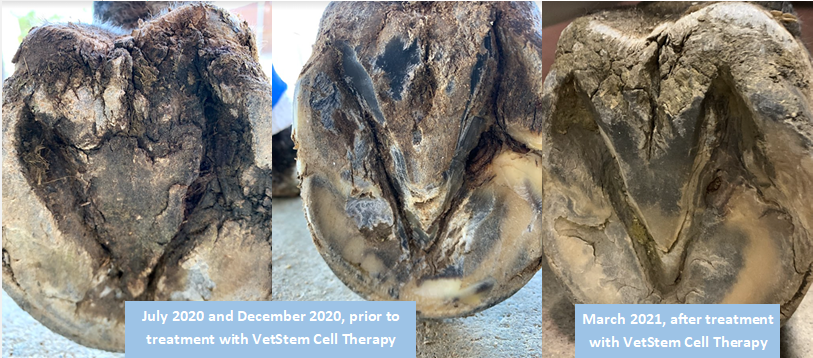Horse Receives VetStem Cell Therapy for Chronic Hoof Infection
Hello VetStemmers! It’s Dr. Amber Vibert here and I’ve taken over the blog again. In honor of it being National Farriers Week, I’d like to share with you a horse hoof case that is near and dear to my heart. The patient was my own 25-year-old, Thoroughbred horse named Valor. Valor came to me as a senior 5 years ago. He had some mild arthritis in his hocks (rear limb “ankles”), and he had back and neck stiffness that likely came from being trained as a racehorse and then a show horse in his early years. However, the condition for which I treated him with VetStem Cell Therapy remains somewhat of an enigma.

Valor’s Hoof Infections
About 3 years into owning him, he developed a deep, severe, focal infection on the underside of both of his rear hooves. Each area measured about the size of a dime in diameter and were deep enough to expose the underlying soft tissue that bled really easily when touched. The infection and inflammation extended into his heels and was super painful for him. Around this time, he also displayed reduced healing capacity for scrapes and cuts on his limbs. Now, older horses are prone to delayed healing and weaker immune system responses as a result of certain metabolic conditions, but sometimes it is the natural progression of the aging process, not unlike elderly humans. So, the first thing I did was I had him examined by his equine veterinarian. Yes, I’m a veterinarian, but my 16 years of clinical practice prior to joining VetStem was working with small animals. Horses are very different from dogs and cats!
Diagnostics and Treatments
We took x-rays of his hooves and found no evidence of a foreign body (i.e., no nails or other penetrating objects) and no draining tracts. We tested Valor for metabolic diseases, immune system diseases and infectious diseases, all of which were negative. I always made sure his living area was clean and dry. We examined and adjusted his nutrition to make sure it was balanced and providing him with appropriate ratios of proteins, carbs, vitamins, and minerals. We also took culture swabs of the focal lesions in his hooves and found a particular type of bacteria in those lesions that could be a factor. But honestly, my veterinarian was stumped as to the underlying cause. I got a second and third opinion with other veterinarians and each had their theories, but none could pinpoint a definitive cause either. So, I treated him for months with an intense regimen of oral and topical antibiotics as well as pain meds in addition to the prescription anti-inflammatory medication he was already taking for his arthritis.
Of course, I got his farrier involved as well. He too, was unsure of the nature of these wounds, as he had never seen anything like it. We tried different podiatric options such as therapeutic shoeing, hoof pads, hoof packing, regular shoeing, and no shoeing at all. I spent countless hours as directed, caring for his feet- picking, washing, soaking, medicating etc. I used Platelet Therapy locally a couple of times- I saturated medical cotton pads with his platelet concentrate (created through the Genesis CS-2 Platelet Rich Plasma Kit) and packed it into the deep lesions. It helped for a short period of time, but it was too labor intensive to do consistently. Despite all of his treatments and the heroic efforts of his wonderful farrier, the improvement was minimal.
Treatment with VetStem Cell Therapy
Then in December 2020 I collected fat tissue from an area on his rump for stem cell processing. He didn’t have a huge cell yield, so we only had one stem cell dose to start with and the rest we grew in cell culture to create more doses. He received his first injection immediately following processing via a regional perfusion (RP) injection in his lower right rear leg. Regional perfusion is an injection into a vein with a tourniquet around the limb above the injection site. The tourniquet stays on for about 30 min after the injection to allow the cells (or other drugs) to be delivered to, and stay concentrated in, all parts of the limb below it. Then approximately 4 and 8 weeks later he received doses in both rear legs, also by RP injection.
The rationale for using stem cell therapy was to reduce inflammation, reduce pain, enhance his immune system’s ability to heal, and provide antibacterial/antifungal properties to his hooves. The only other treatments he received during the time of his stem cell therapy were pain medications and daily hoof cleaning. It was so hard to be patient waiting for the cells to do their thing! But 3 months after his initial treatment, I began to see a dramatic change. The difference was amazing! As you can see from the pictures, between December 2020 and March 2021 his hoof soles became stronger, his heals were no longer swollen and painful, and the focal lesions became significantly smaller.

Sadly, we did not get a chance to see his hoof condition through to complete resolution as I had to put him down in April 2021 due to an unrelated, fast-progressing condition. However, VetStem Cell Therapy provided him with much healthier and more comfortable feet for the last few months of his life. And for this, I will be eternally grateful.
